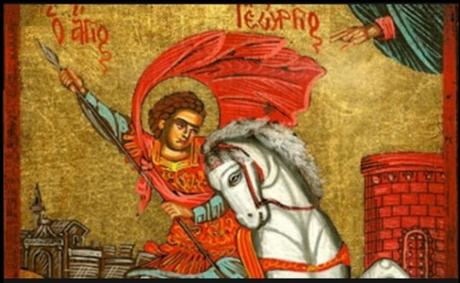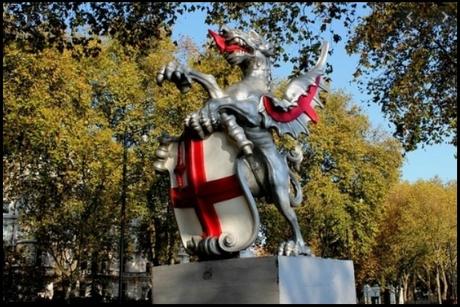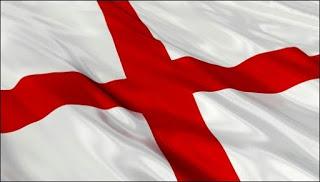Our current prime-minister, Eton and Oxford educated, but not best known for his graft or attention to detail, once stated in a preface he contributed to a book about St. George: "According to Gibbon, he had nothing to do with a dragon, but was a Cappadocian merchant who made a fortune selling bacon to the Roman army. What could be more appropriate? Napoleon said the English were a nation of shopkeepers. He meant it as an insult. We take it as a compliment. It is that spirit of small- business entrepreneurship that encouraged St. George to flog his bacon to the Romans and will lead this country out of recession... Cry God for Harry, England and St. George the seller of bacon!"
I don't know whether tears or laughter are more appropriate in reaction to that load of bombastic bullshit. By the way, did I say this blog is going to be about St. George? It is. And a fascinating tale it will prove (I hope).
First off, we have to debunk the notion of the bacon-selling merchant. If that lazy BoJo (a classics graduate allegedly) had been studious, he would have known that Gibbon got the wrong George! His candidate for St. George (according to The Decline and Fall of the Roman Empire ) was George, Bishop of Alexandria, a corrupt and immoral figure who amassed a personal fortune from collecting taxes and - yes - selling dodgy meat to the Roman army. He actually persecuted orthodox Christians until the Alexandrians rebelled against him, killed him and threw his body into the sea in 362 A.D.
As for the real St. George, he'd already been dead for half a century. Regarding the man behind the considerable myth, most credible scholarly researches suggest the following...

Agios Georgios (Saint George)
He was born around 270 A.D. at Militene in Cappadocia (part of modern-day Turkey) to Christian parents. His father was Greek, son of the governor of the province, and his mother was from Syria. George became a knight in the (heathen) Imperial Roman Army and his religion was not an issue until the turn of the century when Emperor Diocletian, responding to reports of disaffection in some quarters of the army decided that Christians were to blame. He ordered them to renounce their religion and worship the Roman gods instead, on pain of dismissal or death. George refused to renounce his faith. More than that apparently, for while pledging secular allegiance to Rome, he made rather public play of everyone's rights to freedom of faith in religious matters. Because he was of quite high standing, this put him on a collision course with the authorities and when he wouldn't recant in the face of brutal torture, he was executed (apparently on 23rd April) in 303 A.D. He became in the process of the next couple of centuries one of the most venerated of Christian martyrs and all sorts of legends sprang up about his acts of chivalry. Most elements of these legends are apocryphal, of course, staged to serve different religious or national agendas, though it is tempting to think there may be kernels of truth in a few.Take the dragon and the virgin for instance. Allegedly George was stationed in Libya at some time in the late third century (quite plausible in fact, given the nature and reach of the Roman Empire) and was responsible for freeing a city from the grip of bandit warlords, for which the duke of the once beleaguered city gave his daughter in marriage in grateful thanks to George the liberator. It's not hard to see how that became the basis of the rather more colourful legend. What's particularly interesting about George is that he was and is equally venerated by Christianity and Islam, where he is revered as Al-Khidr. The raft of ideals he came to stand for - honesty, valour, emancipation, regeneration - mean that he finds himself patron saint of a swathe of countries (including Ethiopia, Georgia, Greece, Palestine, Portugal, Romania, Russia and Turkey) and occupations and organisations such as farmers, hospitals, shepherds and scouts.
How he came to be patron saint of England is interesting. He'd been revered as a saint and martyr for centuries by the Christian church, and as the soldier-saint had been a talisman for the various Crusades to the Holy Land (where incidentally he was supposed to have been buried at Lydda in Palestine) from the eleventh century on. But it was only during the reign of Edward III that he came to replace St. Edmund as England's official patron saint, with an official declaration in 1351 that "the English nation call upon St. George as being their special patron, particularly in war." Edward also instigated the chivalric Order of the Garter and incorporated the heraldic red cross (for blood) on a white ground (for purity) into royal insignia.
Subsequent to that many stories were written to retrofit St. George into the English chivalric tradition. One such even had him being born in Coventry! His saint day, April 23rd, was celebrated as a holy event by the church and he featured in miracle and morality plays that were put on annually by town guilds up and down the country. In such mummeries, the dragon became known as Snap, presumably because he had a hinged snout that could open and shut to noisy effect.
Although St. George never lost his position as patron saint of England, his popularity waned considerably once Henry VIII broke with Rome and the prevalence of the Catholic church with its idolatry and feast-days declined rapidly from the 16th century onwards. Additionally, once the union with Scotland (and later Northern Ireland) came into being, the cross of St. George became subsumed into the Union flag. Romantic attempts were made to revive interest in St. George during Victoria's reign but to little lasting effect. Union and Empire were the keynotes of her long reign and thus St. George became largely the preserve of the military and the nascent boy scout movement. When George VI wanted to reward gallantry in the second world war, he created the George Cross and the George Medal, not in his name but in the name and with the image of the soldier-saint.
The renaissance, if it can be termed such, has come only recently. For years, even St. Patrick's Day was more of a popular event in this country than St. George's Day but then in the last part of the last century, things began to change. It's almost as though some sections of English society went through some sort of national identity crisis. Shorn of its empire from the 1960s onwards, then becoming part of the European Economic Community in the 1970s, seeing a legitimate influx of peoples from the Commonwealth and then observing moves to devolved government for Northern Ireland, Scotland and Wales, some Englishmen and women suddenly felt downsized, insignificant, wanting to be great again.
Don't get me wrong, I'm proud to be English and I think this country has a lot to be proud of. I'm patriotic but I'm not nationalistic about it. I'm also proud to be European and was happy to be part of the European Union as an international community. I never felt any less English for being in the EU, any more than the French feel less French or the Italians less Italian. I just don't get the insular mind-set. Anyhow, I digress.
A renewed desire to celebrate and recognize an English identity meant an upturn in popularity for St. George, his day and his red and white flag. Football fans and football culture had quite a bit to do with this (and rugby union to a lesser extent), football being one of the few sports in which England rather than Great Britain competes on the world stage. In 1966, the year in which England won the world cup, the flags being flown all around Wembley Stadium were Union flags. Thirty years later at Euro '96 the red and white of St. George had become predominant and continues to be so wherever England matches are played. In 2014 and 2016 came two celebration of William Shakespeare (who famously was born and died on 23rd April) to recognise 450 years since his birth and 400 since his death; and it was Shakespeare of course who wrote those lines in Henry V that BoJo was happy to quote: "Cry God for Harry, England and St. George."
The significant dark stain on all this longing for Englishness is the manner in which the far right extremists, be they the British National Party, England First Party or English Defence League, have co-opted the red and white cross as a standard and their sympathisers have chosen to parade it and wrap themselves in it as a symbol of white Englishness. As one Church of England spokesman put it recently: "It is time that St. George was reclaimed from the dragon, from past associations with racism and the far Right." I'd go further than that and re-educate the people of England in the broader truth and relevance of their patron saint - not just a man of valour, but also a man of color and one who rejected prejudice and died opposing intolerance. "In peace, there's nothing so becomes a man as modest stillness and humility" (that's also Henry V).

'Snap' the dragon
I love the fact that the dragon in the traditional St. George pageants was known as Snap. I love even more the fact of him posing on his plinth in London, proudly holding the shield showing England's colours, with not a saint in sight. One might almost think Snap the dragon stands there victorious in his emancipation, freed at last from centuries of being the bad guy.Here's my latest poem, brought to life in light of the recent Black Lives Matter marches and the various counter-demonstrations they triggered. It was bizarre and frankly frightening to see members and sympathisers of the English Defence League standing round statues in central London giving out Nazi salutes. That, coupled with the deluge of right-wing propaganda all over social media in recent weeks masquerading as 'concerned patriotism' prompted me to write this. I should also add that as a supporters' liaison officer at a professional football club, regrettably I have seen and heard the sort of racist comments that really should have no place in our lives anymore.
It's a bit clunky, perhaps still a work-in-progress; but my thanks go regardless to my fellow poets in Blackpool & the Fylde Stanza group for suggestions and feedback on an original, even clunkier, draft of the poem.
Off White
This one's for a certain breed of football lads.
They all know who they are; the ones who say
"There's too many blacks at our club, in our town,
in our country today. We're becoming a minority.
Share this message if you dare to agree."
Though a bit of poetry might not be their bag,
(poems are for tossers, right?) I felt impelled
to set these lines down anyway, just in case like.
What were you thinking, stood four-square
around our cenotaphs that Saturday in June,
there being neither football games to go to,
nor one single destroyer with defamation his goal?
You criticised a popular campaign for 'virtue signalling',
the most pejorative of put-downs; and yet your tokenism
in defence of white history and tradition was precisely that,
maybe minus the virtue, with the odd Nazi salute thrown in.
Our patron saint was neither very English nor exactly white.
Good St. George was born in what today is eastern Turkey.
I know, you voted 'leave' because the Turks were coming.
More Brexit lies, but that's now by the by. His father? Greek.
His mother? Syrian. I realize it's not getting any better for you,
this true history. What's more, we share our patron saint.
Ethiopia, Georgia, Moldova and Palestine invoke him too,
and he's equally revered by Christians and Muslims. So
bear in mind, next time you wrap yourselves in the flag
of good St. George, or sink a bellyful of foreign beers
to celebrate his national day, that what he truly represents
is the highest principle of valour in defence of diversity,
equality, and the moral right of all to live freely side by side;
the perfect patron saint for a proudly multicultural society,
something to aspire to. It's what he died for, after all.
NB. edit to add: as only 14% of England in 'non-white',
your loaded claims of becoming a minority look slight!

Thanks for reading, and stay safe, S ;-) Email ThisBlogThis!Share to TwitterShare to Facebook
Reactions:
